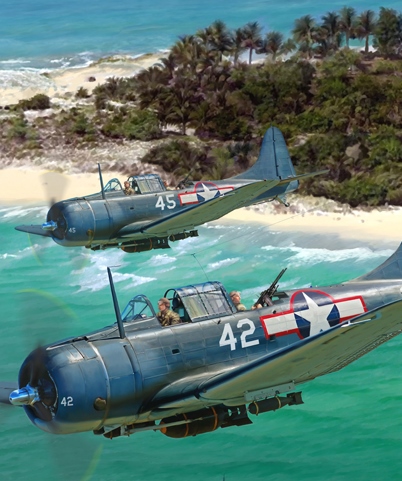BLACK-ALBERT
ALBERT ARTHUR BLACK

MAJ

Albert Arthur Black was born on November 20, 1921, in Fort Madison, Iowa. Following high school graduation in 1939 he attended Culver-Stockton College at Canton, Missouri, until enlisting in the Naval V-5 program at Northwestern in May 1942. Following flight training he became a pilot of a Douglas SBD Dauntless dive bomber assigned to Marine Scout Bombing Squadron 341 (VMSB-341). He served with this squadron during World War II at Samoa, Efate, Munda, Bougainville, Green Island, Emirau and back to Green Island. A memoir written after the war by a radioman/gunner who flew combat in the back seat of his SBD wrote:
“In demeanor, LT Black (affectionately called ‘Ack Ack’ because of his first two initials) did not appear to be a macho know-it-all but a steady, solid by-the-book pilot. He was about the height of 5’7” and blond with a crew cut. For the record I cannot compliment nor give enough accolades to LT A. A. Black. He was the quintessence of a Marine Pilot. I am forever grateful to have been his gunner.”
Following World War II, Albert Arthur Black also wrote his personal memoirs of which the following is an excerpt:
“For all of us who had the feeling that our second tour was turning into a picnic after a few light responses to the April 1944 missions, we had a rude awakening following the May 2 mission. It was the third time that I had my plane hit. The first time was a single bullet hole, the second time was a rather strange incident in that I had just entered a dive and I heard a sound as though I had fired my .50 cal., but I hadn't started firing, so passed it off as just a strange sound. Back at Green Island, my plane went through the usual after-flight inspection for damage and none was found. Later in the day I was informed that a piece of shrapnel was found in the engine cowling and that there were some minor nicks on the back side of the propeller and on the cooling vanes of a couple of cylinders. A small piece of shrapnel had bounced back and forth between the engine and propeller producing a rapid sound like a machine gun before coming to rest in the cowling,”
“I don't know when I started carrying the nickname of "Ack Ack" but the nickname lasted through the war and then went dormant for 50 years to once again surface at our 50th reunion. Our life on Green Island was much more relaxed than it had been on Munda or Bougainville, and much of that can be attributed to the Marine Fighter Squadrons (day and night) that had almost eliminated any form of harassment by enemy aircraft. This made it possible for Green Island to have uninterrupted movies each night in a large open air theater. Our movies were on 16mm film and the quality was great and the subjects interesting. During our second and third tour, while at Green Island, we were entertained by two great traveling USO groups. One was headed by comedian Jack Benny and the other by a never say quit comedian, Bob Hope. Their shows were great, as were the young females that somehow picked up everybody's desire to return to the good old USA. One other visitor that made a stop at Green Island on a fact finding tour was the First Lady, Eleanor Roosevelt. She wasn't there to entertain, so the turn-out for her visit was much smaller and attended mostly by the curious and those who wanted to show their respect for her husband, our Commander In Chief.”
During the Korean War, Black was recalled to active duty and became a helicopter pilot. When he left the Marine Corp with the rank of Major he settled in Tustin, California, where he was a civil engineer. He died on August 14, 1998, and is buried at Riverside National Cemetery in Riverside, California.
Submitted by CDR Roy A. Mosteller, USNR (Ret)

